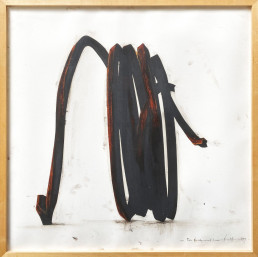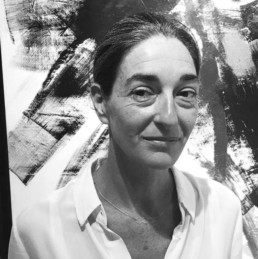Bernar VENET, a French artist born in 1941 and living between France and the United States since the 1960s, is today known worldwide for his sculptures and recognised for his monumental installations in the public domain.
We would like to focus here on another part of his compositions: his graphic work. We will base this article on two works on paper recently acquired by the gallery, which perfectly illustrate the importance of drawing in the sculptor’s creative process.

Bernar VENET – Two Undetermined Lines, 1989 – Oil pastels on paper – 76.2 x 76.2 cm
“First, I have a vision. Then I make a small drawing with the main precaution being the question of proportions “.
From his first artistic experiences, Bernar VENET gives the drawing a predominant and omnipresent place. From mathematical formulas written with ink on large papers, to industrial technical diagrams presenting the physical characteristics of an object produced and shown at the same time in volume, Venet’s graphic works are inseparable from his sculptures.
Like many artists, drawing is the first stage in Bernar Venet’s work and he will build his sculptural project through it. Moreover, the sculptor can be felt behind each of the artist’s sketches: the relief and perspectives make each drawing a wall sculpture. The flat work seems to be already present in volume, it seems to come out of its frame. Here, the preparatory drawing is not a sketch but a fully-fledged, finished work that stands on its own and presents us with the essence of the subject to which Venet will give life. The movement, relief, texture and colours of the pastel give us the grainy, rusty aspect of the Corten steel that will constitute the material of the sculpture to be born. The attention is already entirely concentrated on the form, no superfluous detail disturbs the eye. Ingres gave this advice to his students: “Have the figure you want to represent entirely in your eyes and in your mind, and let the execution be nothing more than the accomplishment of this already possessed and preconceived image”. With a lively, sober, powerful and elegant gesture, Venet goes straight to his goal, follows his Line, a central element of his work since the 1960s, the volume of which he already feels, and remains faithful to what he calls the principle of equivalence, which makes it possible to transmit the same content through different channels.
The second stage is the casting of the sculpture in black or Corten steel according to the drawing. Then, in a third step, the artist will try to give yet another vision of his work, this time from a photographic view of his sculpture.
In Venet’s case, there is an absolute circularity between drawing, sculpture and photography. The form and its metaphors are contiguous and reflect the artist’s desire to achieve the absolute object, one whose aspect refers only to itself without expressiveness, totally neutral, depersonalised. This was already the aim of Bernar Venet during his first artistic experiments based on the use of diagrams and mathematical formulas, or also through his performance around the “coal pile”: “The charcoal, placed freely in a heap, freed the sculpture from the apriorities of the composition imposed by the artist. The material, always poor (coal, tar, steel…), used for its own capacities, decides on its own form which will be different with each use, thus allowing the artist’s personality to disappear behind his work. Through the raw and industrial materials he chooses, Venet further emphasises the radical and self-referential nature of his research: the work must speak only of itself and not of the artist. It is on this monosemia principle that he has based his thinking since the beginning.
Bernar VENET – Indeterminate Line, 2016 – Photograph and charcoal on paper – 220 x 153 cm
This Indeterminate Line, created in 2016, is entirely representative of the style and strength of Venet’s work: at once minimal and monumental, even colossal, the line takes over the space with its presence and movement. Here we are faced with what could be described as the third stage of his work: after the preparatory drawing and the making of the sculpture, the artist seeks to give another vision of this volume. He then chooses an angle of view which he fixes photographically and reworks into a flat. The photo is then cut out following the contours of the sculptural form, pasted onto a large white paper and reworked with charcoal. This tool, made from charcoal (well, look at that…), used since prehistoric times in cave art, which is as raw as it gets, is generally associated with preliminary work because it is very easily erased. Here again, Venet goes against the grain. He glorifies charcoal through its use in the final work. The specific characteristics of charcoal allow him to add depth to his work and to play with light by varying the value of the black, more or less blurred. The rough and raw texture of charcoal can also recall the feel of steel. And the circle is complete!
«Expanding the field of the visual world»
Bernar Venet became an artist at a time when lyrical abstraction was exploding in France and conceptual art in the United States. He did not adhere to these movements and sought something else to broaden the field of creation. He therefore found his inspiration elsewhere, in disciplines outside the art world such as mathematics, geometry and physics.
His work will develop around a theme: the Line, which will become straight, curved, indeterminate before being transformed into Arcs and Angles. From the outset, his work was radical, even austere, compared to the generally lyrical and colourful abstract art of the 1960s. Using black and industrial materials, with a minimal and deliberately inexpressive gesture, he wanted to achieve the absolute object, one whose form would refer only to itself and not to the artist’s “style”. He remained faithful to the initial principles of his creation (principle of equivalence, refusal of aesthetics and monosemia principle) on which he based a protean work: paintings, sculptures, drawings, photographs, architecture, poetry, sound works, films…
A major artist of conceptual and minimal art, the father of informal art born with his “coal pile “, Bernar VENET is today present in some sixty museums throughout the world and receives numerous public and private commissions for permanent and often monumental installations.

Maud Barral
After 15 years spent as the assistant of the famous gallerist Jean Ferrero, whose gallery has been the main center of creation for the artists of the School of Nice and the Nouveaux-Réalistes movements, Maud has then opened for 5 years her own gallery, supporting contemporary young artists. Then, she has decided to enter the Galerie Hurtebize, in 2015.


